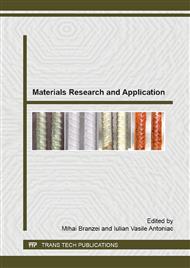p.183
p.190
p.196
p.206
p.214
p.219
p.224
p.229
p.233
Thermal Shock Influence on some Abrasive Wear Resistant Nickel and Cobalt Complex Alloy’s Microstructure and Properties
Abstract:
The present paper shows the experimental results obtained on two complex alloys Co-Cr-W-C-Fe-Ni-Si-Mn-Mo and Ni-Cr-Fe-B-Si-C-Co alloys deposited on copper support by welding (TIG). Well - known for their excellent abrasive wear, corrosion and high temperature erosion resistance, these materials were chosen as protective solutions for some highly mechanically and thermally stressed devices, namely the blast tuyeres of blast furnaces. A testing method which simulates as near as possible the real working conditions is the quick thermal shock, consisting in heating at the chosen testing temperature followed by cooling in cool air spray, for 25 cycles. Testing parameters were set according to the blast tuyere device working conditions. In this paper, the coatings microstructure’s comparative changes consequently to quick thermal shock were monitoring, because this affect the device lifetime and mechanical characteristics. The untested samples as well as on quick thermal shocked ones was investigated using X-ray diffraction, scanning electron microscopy (SEM) and energy dispersive X-ray spectroscopy (EDS).
Info:
Periodical:
Pages:
214-218
Citation:
Online since:
July 2015
Authors:
Keywords:
Price:
Сopyright:
© 2015 Trans Tech Publications Ltd. All Rights Reserved
Share:
Citation:


